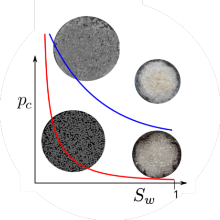Description
Carbon Capture and Storage (CCS) will be have to be utilized in the near future to mitigate the global climate change by reducing the emissions of CO2, which is thus not emitted, but rather injected in the subsurface. Also for an optimal use of renewable energies, gas will need to be stored underground to buffer the fluctuating supply and demand. Such gases may be either natural gas or synthetic methane (CH4) or hydrogen (H2) or simply compressed air. Optimal reservoirs for gas storage are located in variable depths, depending on geological conditions and the gas which is to be stored. They are separated from overlying aquifers by an impermeable cap rock. For a successfully operating storage, it is a necessity to avoid any leakage of stored gases.
Thus, further research to improve sealing technologies used to mitigate potential leakage, like the injection of cement or biomineralization is necessary, which requires understanding of both the (bio-) and geochemical reactions and the transport of the different components in both gas and water phase. Microbially induced calcium carbonate precipitation (MICP) is currently becoming an established method of biomineralization and in previous projects, a numerical model was developed for this biomineralization method. However, precipitation may also be induced by injection of extracted or plant-based sources of urease or at elevated temperatures. Experimental investigations of our collaborators at Montana State University (MSU) in Bozeman, USA focus on ureolysis-based methods involving enzyme (EICP) or elevated temperatures (TICP) instead of microbes to incude calcium carbonate precipitation. The applicability of a certain method is largely determined by the depth below ground surface and the local geothermal gradient. MICP relies on the activity of living bacterial cells, which only thrive within a limited temperature range (<45°C). This temperature range may include the shallow subsurface, where CH4 or natural gas may be stored, but is lower than the temperatures commonly present at depths suitable for CO2 storage. As a consequence, other technologies such as EICP or TICP have to be developed and demonstrated in the field.
The main goal of this project is to include the effects of ICP on the two-phase flow behavior as, with regard to using ICP to mitigate gas leakage from subsurface reservoirs, sufficient sealing might not necessarily depend on reducing the intrinsic permeability, but rather rely on increasing the entry pressure of the cap rock to values higher than the reservoir pressure. Further, in two phase flow, an effect described by the so-called relative permeability occurs, when the presence of one fluid phase hinders the movement of another. Relative permeability is depending not only on the fluid properties, but also on the geometry and surface properties of the porous medium. Thus, ICP likely has an effect on relative permeability as well, as the pore sizes decrease and calcium carbonate, potentially not present before, is covering the pore surfaces and thus determining the solid-fluid interactions. Additionally, of course also the intrinsic permeability for a fully-saturated single-fluid-phase case is reduced, as more and more mineral is precipitated. All these effects of ICP on porous medium properties in turn also affect the ICP processes themselves, as the (bio-)geochemical reactions depend on the supply of reactants with the fluid flow. E.g. when a pore throat is completely blocked, the adjacent pore bodies may end up as dead-end pores into which no further flow occurs and all further reactants can only reach them by diffusion, limiting the supply of reactants to the initial plugging precipitated mineral, thus reducing its further growth rate. Similar effects may occur also on larger scales.
Therefore, it is important to include such effects of ICP on porous medium properties into the models for ICP to be able to not only correctly assess the effects of ICP in terms of sealing success, but also, to predict the actual ICP processes as accurately as possible.
Project Leader
Dr.-Ing. Johannes Hommel
Researcher
Dr.-Ing. Johannes Hommel
Department
Duration
04/2021 - 01/2026
Publications
(Journal-) Articles
- Lee, D., Weinhardt, F., Hommel, J., Piotrowski, J., Class, H., & Steeb, H. (2023). Machine learning assists in increasing the time resolution of X-ray computed tomography applied to mineral precipitation in porous media. Scientific Reports, 13, 10529. https://doi.org/10.1038/s41598-023-37523-0
- Hommel, J., Gehring, L., Weinhardt, F., Ruf, M., & Steeb, H. (2022). Effects of Enzymatically Induced Carbonate Precipitation on Capillary Pressure-Saturation Relations. Minerals, 12(10), Article 10. https://doi.org/10.3390/min12101186
- Scheurer, S., Schäfer Rodrigues Silva, A., Mohammadi, F., Hommel, J., Oladyshkin, S., Flemisch, B., & Nowak, W. (2021). Surrogate-based Bayesian comparison of computationally expensive models: application to microbially induced calcite precipitation. Computational Geosciences. https://doi.org/10.1007/s10596-021-10076-9
- von Wolff, L., Weinhardt, F., Class, H., Hommel, J., & Rohde, C. (2021). Investigation of Crystal Growth in Enzymatically Induced Calcite Precipitation by Micro-Fluidic Experimental Methods and Comparison with Mathematical Modeling. Transport in Porous Media, 137(2), Article 2. https://doi.org/10.1007/s11242-021-01560-y
- Hommel, J., Akyel, A., Frieling, Z., Phillips, A. J., Gerlach, R., Cunningham, A. B., & Class, H. (2020). A Numerical Model for Enzymatically Induced Calcium Carbonate Precipitation. Applied Sciences, 10(13), Article 13. https://doi.org/10.3390/app10134538
- Cunningham, A. B., Class, H., Ebigbo, A., Gerlach, R., Phillips, A., & Hommel, J. (2019). Field-scale modeling of microbially induced calcite precipitation. Computational Geosciences, tbd. https://doi.org/10.1007/s10596-018-9797-6
- Hommel, J., Coltman, E., & Class, H. (2018). Porosity-Permeability Relations for Evolving Pore Space: A Review with a Focus on (Bio-)geochemically Altered Porous Media. Transport in Porous Media, 2(124), Article 124. https://doi.org/10.1007/s11242-018-1086-2
Datasets
- Lee, D., Weinhardt, F., Hommel, J., Class, H., & Steeb, H. (2023). Time resolved micro-XRCT dataset of Enzymatically Induced Calcite Precipitation (EICP) in sintered glass bead columns. DaRUS. https://doi.org/10.18419/darus-2227
- Ruf, M., Hommel, J., & Steeb, H. (2022). Enzymatically induced carbonate precipitation and its effect on capillary pressure-saturation relations of porous media - micro-XRCT dataset of medium column (sample 3). DaRUS. https://doi.org/10.18419/darus-2906
- Hommel, J., & Gehring, L. (2022). Enzymatically induced carbonate precipitation and its effect on capillary pressure-saturation relations of porous media - column samples. DaRUS. https://doi.org/10.18419/darus-1713
- Ruf, M., Hommel, J., & Steeb, H. (2022). Enzymatically induced carbonate precipitation and its effect on capillary pressure-saturation relations of porous media - micro-XRCT dataset of high column (sample 4). DaRUS. https://doi.org/10.18419/darus-2907
- Hommel, J., & Weinhardt, F. (2022). Enzymatically induced carbonate precipitation and its effect on capillary pressure-saturation relations of porous media - microfluidics samples. DaRUS. https://doi.org/10.18419/darus-2791
- Ruf, M., Hommel, J., & Steeb, H. (2022). Enzymatically induced carbonate precipitation and its effect on capillary pressure-saturation relations of porous media - micro-XRCT dataset of low column (sample 10). DaRUS. https://doi.org/10.18419/darus-2908
Contact

Johannes Hommel
Dr.-Ing.Academic Staff



